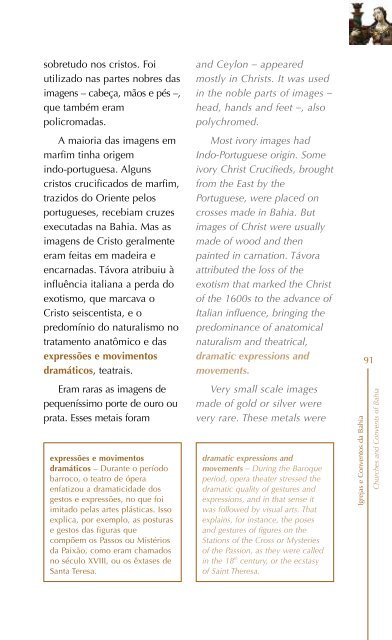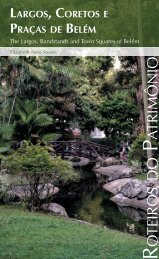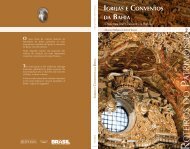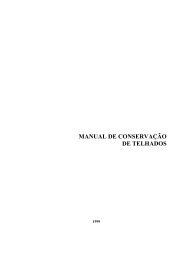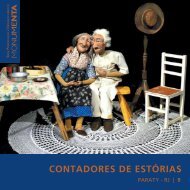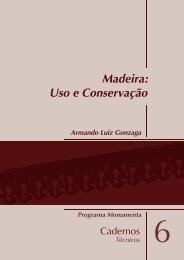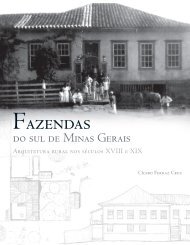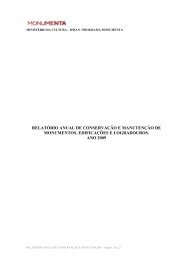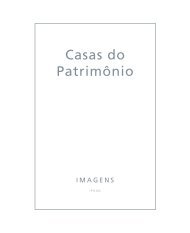Igrejas e Conventos da Bahia - Monumenta
Igrejas e Conventos da Bahia - Monumenta
Igrejas e Conventos da Bahia - Monumenta
Create successful ePaper yourself
Turn your PDF publications into a flip-book with our unique Google optimized e-Paper software.
sobretudo nos cristos. Foi<br />
utilizado nas partes nobres <strong>da</strong>s<br />
imagens – cabeça, mãos e pés –,<br />
que também eram<br />
policroma<strong>da</strong>s.<br />
A maioria <strong>da</strong>s imagens em<br />
marfim tinha origem<br />
indo-portuguesa. Alguns<br />
cristos crucificados de marfim,<br />
trazidos do Oriente pelos<br />
portugueses, recebiam cruzes<br />
executa<strong>da</strong>s na <strong>Bahia</strong>. Mas as<br />
imagens de Cristo geralmente<br />
eram feitas em madeira e<br />
encarna<strong>da</strong>s. Távora atribuiu à<br />
influência italiana a per<strong>da</strong> do<br />
exotismo, que marcava o<br />
Cristo seiscentista, e o<br />
predomínio do naturalismo no<br />
tratamento anatômico e <strong>da</strong>s<br />
expressões e movimentos<br />
dramáticos, teatrais.<br />
Eram raras as imagens de<br />
pequeníssimo porte de ouro ou<br />
prata. Esses metais foram<br />
expressões e movimentos<br />
dramáticos – Durante o período<br />
barroco, o teatro de ópera<br />
enfatizou a dramatici<strong>da</strong>de dos<br />
gestos e expressões, no que foi<br />
imitado pelas artes plásticas. Isso<br />
explica, por exemplo, as posturas<br />
e gestos <strong>da</strong>s figuras que<br />
compõem os Passos ou Mistérios<br />
<strong>da</strong> Paixão, como eram chamados<br />
no século XVIII, ou os êxtases de<br />
Santa Teresa.<br />
and Ceylon – appeared<br />
mostly in Christs. It was used<br />
in the noble parts of images –<br />
head, hands and feet –, also<br />
polychromed.<br />
Most ivory images had<br />
Indo-Portuguese origin. Some<br />
ivory Christ Crucifieds, brought<br />
from the East by the<br />
Portuguese, were placed on<br />
crosses made in <strong>Bahia</strong>. But<br />
images of Christ were usually<br />
made of wood and then<br />
painted in carnation. Távora<br />
attributed the loss of the<br />
exotism that marked the Christ<br />
of the 1600s to the advance of<br />
Italian influence, bringing the<br />
predominance of anatomical<br />
naturalism and theatrical,<br />
dramatic expressions and<br />
movements.<br />
Very small scale images<br />
made of gold or silver were<br />
very rare. These metals were<br />
dramatic expressions and<br />
movements – During the Baroque<br />
period, opera theater stressed the<br />
dramatic quality of gestures and<br />
expressions, and in that sense it<br />
was followed by visual arts. That<br />
explains, for instance, the poses<br />
and gestures of figures on the<br />
Stations of the Cross or Mysteries<br />
of the Passion, as they were called<br />
in the 18 th century, or the ecstasy<br />
of Saint Theresa.<br />
<strong>Igrejas</strong> e <strong>Conventos</strong> <strong>da</strong> <strong>Bahia</strong><br />
91<br />
Churches and Convents of <strong>Bahia</strong>


